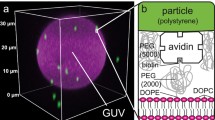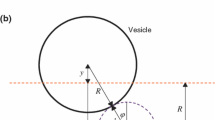Abstract
We develop a two dimensional model of a vesicle adhered on a curved substrate via long-range molecular interactions while subjected to a detachment force. The relationship between the force and displacement of the vesicle is investigated as a function of the substrate shape. It is shown that both the force– displacement relationship and the maximum force at pull-off are significantly dependent on the substrate shape. The results suggest that probes with different tip shapes may be designed for cell manipulation. For example, we demonstrate that a vesicle can be pulled off a flat surface using a probe with a curved tip.
Similar content being viewed by others
References
Johnson K.L., Kendall K., Roberts A.D. (1971) Surface energy and contact of elastic solids. Proc. R. Soc. Lond. A 324, 301–313
Derjaguin B.V., Muller V.M., Topovov Y.P. (1975) Effect of contact deformations on adhesion and particles. J. Colloid Interface Sci. 53, 314–326
Maugis D. (1992) Adhesion of spheres – The JKR-DMT transition using a Dugdale model. J. Colloid Interface Sci. 150, 243–269
Chen S.H., Gao H. (2006) Adhesive contact of an elastic cylinder on stretched substrate. Proc. R. Soc. Lond. A 462, 211–228
Chu Y.S., Dufour S., Thiery J.P., Perez E., Pincet F. (2005) Johnson-Kendall-Roberts theory applied to living cells. Phys. Rev. Lett. 94: 028102-1–028102-4
Gao H., Shi W., Freund L.B. (2005) Mechanics of receptor- mediated endocytosis. Proc. Nat. Acad. Sci. 102: 9469–9474
Zhu C., Bao G., Wang N. (2000) Cell mechanics: Mechanical response, cell adhesion, and molecular deformation. Annu. Rev. Biomed. Eng. 2, 189–226
Alberts B., Johnson A., Lewis J., Raff M., Roberts K., Walter P. (2002) Molecular Biology of the Cell. Garland Science, New York
Lipowsky R. (1998) Vesicles and biomembranes. In: Trigg F.L. (eds) Encyclopedia of Applied Physics. WCH Publishers, Weiheim and New York, pp. 199–222
Canham P.B. (1970) Minimum energy of bending as a possible explanation of biconcave shape of human red blood cell. J. Theor. Biol. 26, 61–81
Helfrich W. (1973) Elastic properties of lipid bilayers – theory and possible experiments. Z. Naturforsch. C 28, 693–703
Freund L.B., Lin Y. (2004) The role of binder mobility in spontaneous adhesive contact and implications for cell adhesion. J. Mech. Phys. Solids 52: 2455–2472
Bell G.I. (1978) Models for the specific adhesion of cells to cells. Science 200, 618–627
Bell G.I., Dembo M., Bongrand P. (1984) Cell adhesion: competition between nonspecific repulsion and specific bonding. Biophys. J. 45: 1051–1064
Dembo M., Torney D.C., Saxman K., Hammer D. (1988) The reaction-limited kinetics of membrane-to-surface adhesion and detachment. Proc. R. Soc. Lond. B 234, 55–83
Boulbitch A., Guttenberg Z., Sackmann E. (2001) Kinetics of membrane adhesion mediated by ligand-receptor interaction studied with a biomimetic system. Biophys. J. 81: 2743–2751
Brochard-Wyart F., de Gennes P.G. (2002) Adhesion induced by mobile binders: dynamics. Proc. Natl. Acad. Sci. USA 99, 854–859
Seifert U., Lipowsky R. (1990) Adhesion of vesicles. Phys. Rev. A 42: 4768–4771
Lipowsky R. (1991) The conformation of membranes. Nature 349, 475–481
Seifert U. (1991) Adhesion of vesicles in two dimensions. Phys. Rev. A 43: 6803–6814
Seifert U. (1997) Configurations of fluid membranes and vesicles. Adv. Phys. 46, 13–137
Seifert U. (1999) Hydrodynamic lift on bound vesicles. Phys. Rev. Lett. 83, 876–879
Boulbitch A. (2002) Enforced unbinding of bead adhering to a biomembrane by generic force. Europhys. Lett. 59, 910–915
Boulbitch A. (2003) Enforced unbinding of biomembranes whose mutual adhesion is ediated by a specific interaction. Eur. Biophys. J. Biophys. Lett. 31, 637–642
Pierrat S., Brochard-Wyart F., Nassop P. (2004) Enforced detachment of red blood cells adhering to a surface: static and dynamics. Biophys. J. 87: 2855–2869
Smith A.S., Sackmann E., Seifert U. (2003) Effects of a pulling force on the shape of a bound vesicle. Europhys. Lett. 64, 281–287
Smith A.S., Sackmann E., Seifert U. (2004) Pulling tethers from adhered vesicles. Phys. Rev. Lett. 92: 208101-1–208101-4
Guttenberg Z., Bausch A.R., Hu B., Bruinsma R., Moroder L., Sackmann E. (2000) Measuring ligand-receptor unbinding forces with magnetic beads: Molecular leverage. Langmuir 14: 8984–8993
Spolenak R., Gorb S., Gao H., Arzt E. (2005) Effects for contact shape on the scaling biological attachments. Proc. R. Soc. Lond. A, 461, 305–319
Gao H., Yao H. (2004) Shape insensitive optimal adhesion of nanoscale fibrillar structures. Proc. Natl. Acad. Sci. USA 101: 7851–7856
Ou-Yang Z.C., Helfrich W.(1987) Instability and deformation of a spherical vesicle by pressure. Phys. Rev. Lett. 59: 2486–2488
Ou-Yang Z.C., Helfrich W. (1989) Bending energy of vesicle membranes: general expressions for the first, second and third variation of the shape energy and applications to spheres and cylinders. Phys. Rev. A 39: 5280–5288
Julicher F., Lipowsky R. (1996) Shape transformations of vesicles with intramembrane domains. Phys. Rev. E 53: 2670–2683
Pierres A., Benoliel A.M., Bongrand P. (2002) Cell fitting to adhesive surfaces: a prerequisite to firm attachment and subsequent events. Eur. Cells Mater. 3, 31–45
Evans E., Yeung A. (1994) Hidden dynamics in rapid changes of bilayer shape. Chem. Phys. Lipids 73, 39–56
Evans E., Bowman H., Leung A., Needham D., Tirrell D. (1996) Biomembrane templates for nanoscale conduits and networks. Science 273, 933–935
Heinrich V., Bozic B., Svetina S., Zeks B. (1999) Vesicle deformation by an axial load: from elongated shapes to tether vesicles. Biophys. J. 76: 2056–2071
Derenyi I., Julicher F., Prost J. (2002) Formation and interaction of membrane tubes. Phys. Rev. Lett. 88: 238101-1–238101-4
Powers T.R., Huber G., Goldstein R.E. (2002) Fluid-membrane tethers: minimal surfaces and elastic boundary layers. Phys. Rev. E 65: 041901-1–041901-11
Author information
Authors and Affiliations
Corresponding authors
Additional information
The project supported by the National Natural Science Foundation of China (10525210 and 10121202) and the 973 Program.
Rights and permissions
About this article
Cite this article
Shi, W., Feng, X.Q. & Gao, H. Two-dimensional model of vesicle adhesion on curved substrates. Acta Mech Sin 22, 529–535 (2006). https://doi.org/10.1007/s10409-006-0036-3
Received:
Accepted:
Published:
Issue Date:
DOI: https://doi.org/10.1007/s10409-006-0036-3




